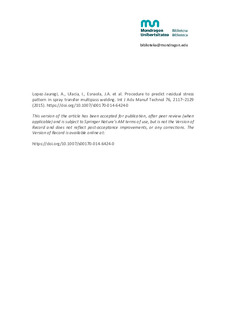
Izenburua
Procedure to predict residual stress pattern in spray transfer multipass weldingBertsioa
Postprinta
Eskubideak
© 2014, Springer-Verlag LondonSarbidea
Sarbide irekiaArgitaratzailearen bertsioa
http://dx.doi.org/10.1007/s00170-014-6424-0Non argitaratua
The International Journal of Advanced Manufacturing Technology Vol. 76. Nº 9. Pp. 2117-2129. February, 2015Lehenengo orria
2117Azken orria
2129Argitaratzailea
SpringerGako-hitzak
Multipass WeldingAnalytic procedure
Finite element method
Laburpena
Gas metal arc welding (GMAW) is one of the most used joining method in the industry. However, one of the main problems of this process is the generation of residual stresses which have direct impact o ... [+]
Gas metal arc welding (GMAW) is one of the most used joining method in the industry. However, one of the main problems of this process is the generation of residual stresses which have direct impact on the fatigue life of welded components. Nevertheless, residual stress pattern prediction is complex and requires the simulation of the welding process. Currently, there are different numerical methods to predict the residual stresses generated in GMAW process, being Goldak’s method one of the most widely used model. However, the main limitation of these methods is that they require defining many parameters experimentally and, consequently, this method is not valid during design process. Alternatively, in this work, it is developed a procedure where the heat source is defined based on the welding physics for spray transfer welding. The developed procedure has been validated for a spray transfer multipass butt weld case. Results have shown good correspondence with an average deviation of 9.16 % in thermal field and 42 MPa in the final residual stress field. Thus, the developed procedure has been validated as a cost-effective alternative method to estimate residual stress pattern in spray transfer multipass welding. Furthermore, the developed method does not require any welding experimental characterization once the efficiency of the used welding machine is defined. The proposed method can be used as a valid tool to optimize the welding process in order to minimize the residual stress field and, consequently, improve the fatigue life. [-]





















